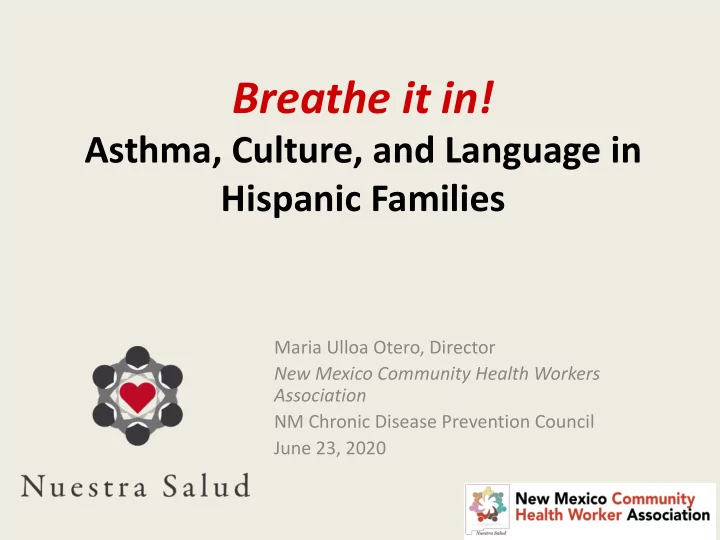

Breathe ¡it ¡in! ¡ Asthma, ¡Culture, ¡and ¡Language ¡in ¡ Hispanic ¡Families Maria ¡Ulloa ¡Otero, ¡Director ¡ New ¡Mexico ¡Community ¡Health ¡Workers ¡ Association NM ¡Chronic ¡Disease ¡Prevention ¡Council June ¡23, ¡2020
The mission of Nuestra Salud is to reduce health disparities affecting Hispanic communities in New Mexico and the nation through research, training, and outreach. 2
Acknowledgements Many ¡thanks ¡to ¡our ¡community ¡participants ¡and ¡families ¡for ¡their ¡courage ¡and ¡ commitment ¡to ¡share ¡their ¡knowledge ¡and ¡opinions Nuestra ¡Salud ¡and ¡ • Community ¡Health ¡ Workers: ¡Maria ¡Otero, ¡ Monica ¡Toquinto, ¡Marissa ¡ Elias, ¡Rosa ¡Lopez, ¡Lourdes ¡ Valencia. New ¡Mexico ¡Department ¡ • of ¡Health ¡Asthma ¡Control ¡ Program San ¡Juan ¡College/ ¡ • Engaging ¡Latino ¡ Communities ¡for ¡ Education ¡(ENLACE) Clovis ¡Public ¡Library • 3
Objectives 1. Increase ¡understanding ¡of ¡Hispanic ¡family ¡ culture ¡related ¡to ¡asthma ¡and ¡children 2. Increase ¡awareness ¡of ¡ photovoice model ¡and ¡ relevance ¡to ¡community ¡empowerment 3. Increase ¡understanding ¡of ¡how ¡the ¡ photovoice ¡approach ¡was ¡effective ¡for ¡ addressing ¡this ¡topic ¡in ¡this ¡culture 4. Identify ¡key ¡elements ¡of ¡this ¡project ¡that ¡ may ¡apply ¡to ¡other ¡topics ¡and ¡communities 4
Background HISPANIC ¡FAMILIES ¡AND ¡ASTHMA ¡ IN ¡NEW ¡MEXICO 5
Background: ¡New ¡Mexico ¡Hispanic ¡Population New ¡Mexico’s ¡Hispanic ¡and ¡Spanish-‑speaking ¡population ¡is ¡ large • – Nearly ¡one ¡million ¡people ¡(48% ¡of ¡the ¡state ¡population) ¡are ¡Hispanic – About ¡29% ¡of ¡the ¡state’s ¡total ¡population ¡say ¡they ¡speak ¡Spanish ¡at ¡least ¡half ¡of ¡ the ¡time ¡at ¡home, ¡more ¡than ¡half ¡a ¡million ¡people ¡(543,100) – About ¡150,000 ¡say ¡they ¡speak ¡English ¡“less ¡than ¡very ¡well” New ¡Mexico’s ¡Hispanic ¡population ¡is ¡ diverse • – Two-‑thirds ¡are ¡of ¡Mexican ¡heritage – Others ¡are ¡Puerto ¡Rican, ¡Cuban, ¡from ¡ multiple ¡countries ¡of ¡Central ¡or ¡South ¡ America ¡ They ¡face ¡ barriers ¡to ¡healthcare • – In ¡comparison ¡to ¡English-‑speaking ¡ Hispanics, ¡Spanish-‑speakers ¡are ¡more ¡ likely ¡to ¡experience ¡poverty; ¡less ¡likely ¡ to ¡have ¡access ¡to ¡healthcare. Sources: ¡Population ¡size ¡data ¡from ¡U.S. ¡Census ¡Bureau, ¡2010 ¡Census ¡and ¡2015 ¡update; ¡2007-‑2011 ¡American ¡Community ¡Survey. ¡ 6 Chart ¡data ¡from ¡New ¡Mexico ¡BRFSS ¡2011-‑2013 ¡combined. ¡* ¡indicates ¡statistically ¡significant ¡difference ¡between ¡groups.
Asthma • Asthma ¡is ¡a ¡complex ¡chronic ¡medical ¡condition – Airway ¡inflammation ¡and ¡constriction ¡make ¡it ¡hard ¡to ¡ breathe; ¡symptoms ¡include ¡wheezing, ¡coughing, ¡chest ¡ tightness, ¡shortness ¡of ¡breath – Can ¡be ¡mild, ¡moderate ¡or ¡severe, ¡even ¡causing ¡death – “Triggers” ¡like ¡dust, ¡mold, ¡pet ¡dander ¡can ¡make ¡symptoms ¡ worse – Effective ¡“control” ¡may ¡include ¡taking ¡quick-‑relief ¡and/or ¡ preventive ¡medication, ¡and ¡reducing ¡exposure ¡to ¡triggers; ¡ a ¡“control ¡plan” ¡should ¡be ¡developed ¡together ¡with ¡a ¡ healthcare ¡provider • Culture ¡and ¡language ¡can ¡further ¡add ¡to ¡the ¡challenges ¡ of ¡identification ¡and ¡control 7
Asthma ¡among ¡Hispanic ¡New ¡Mexicans • About ¡4% ¡of ¡Spanish-‑speaking ¡and ¡10% ¡of ¡ English-‑speaking ¡Hispanic ¡adults ¡have ¡been ¡ diagnosed ¡with ¡asthma ¡by ¡a ¡doctor ¡ • About ¡one ¡in ¡four ¡(25%) ¡high ¡school-‑aged ¡ Hispanic ¡youth ¡has ¡ ever ¡ been ¡told ¡they ¡have ¡ asthma – one ¡in ¡ten ¡(11%) ¡high ¡school-‑aged ¡Hispanic ¡youth ¡ currently has ¡asthma 8 Data ¡source: ¡Asthma ¡among ¡adults ¡from ¡New ¡Mexico ¡(NM) ¡BRFSS ¡2013-‑2015 ¡combined; ¡youth ¡data ¡from ¡NM ¡Youth ¡Risk ¡& ¡Resiliency ¡Survey ¡2017.
Less ¡asthma ¡among ¡Spanish-‑speaking ¡ Hispanics? PROBABLY ¡NOT • Asthma ¡prevalence ¡is ¡ – similar ¡to ¡the ¡general ¡population ¡for ¡English-‑ speaking ¡Hispanics – lower ¡for ¡Spanish-‑speaking ¡Hispanics • Asthma ¡may ¡be ¡under-‑reported ¡among ¡ Spanish-‑speaking ¡people ¡due ¡to ¡lack ¡of ¡access ¡ to ¡healthcare ¡providers ¡for ¡routine ¡care, ¡or ¡ failure ¡to ¡communicate ¡effectively ¡about ¡the ¡ condition 9
Improving ¡understanding ¡of ¡asthma ¡care ¡ among ¡Spanish-‑speaking ¡families ¡ • Nuestra ¡Salud conducted ¡ focus ¡groups ¡with ¡ Spanish-‑speaking ¡parents ¡ of ¡children ¡with ¡asthma ¡ in ¡2015-‑2016 ¡ – 57 ¡total ¡participants – 6 ¡groups ¡at ¡3 ¡sites ¡across ¡ the ¡state – Most ¡(91%) ¡said ¡their ¡ children ¡were ¡taking ¡ asthma ¡medications 10 Source: ¡Spanish-‑speaking ¡parents: ¡perspectives ¡on ¡asthma ¡care ¡for ¡children. ¡ Nuestra ¡Salud , ¡2017.
Talking ¡with ¡a ¡Doctor ¡About ¡Causes ¡of ¡Asthma: ¡ Stronger ¡Beliefs ¡About ¡Effectiveness ¡of ¡Asthma ¡ Prevention ¡and ¡Control Have ¡talked ¡with ¡doctor Not ¡talked ¡with ¡doctor 84% 43% 100% 39% Believe ¡asthma ¡attacks ¡can ¡be ¡prevented Believe ¡asthma ¡can ¡be ¡controlled Source: ¡Spanish-‑speaking ¡parents: ¡perspectives ¡on ¡asthma ¡care ¡for ¡children. ¡ Nuestra ¡Salud , ¡2017. ¡Overall ¡(both ¡groups ¡combined) ¡59% ¡overall ¡believe ¡asthma ¡ attacks ¡can ¡be ¡prevented; ¡66% ¡overall ¡believe ¡that ¡asthma ¡can ¡be ¡controlled. ¡Differences ¡by ¡group ¡were ¡statistically ¡significant. ¡ 11
Talking ¡with ¡a ¡Doctor ¡about ¡Causes ¡of ¡Asthma: ¡ Greater ¡Knowledge ¡of ¡Asthma ¡Risk ¡Factors ¡or ¡Triggers % ¡who ¡knew ¡about ¡risk ¡factor/trigger 17% Cockroaches 56% 24% Carpet/rugs 68% Not ¡talked ¡with ¡doctor 21% Woodstove ¡smoke Have ¡talked ¡with ¡doctor 68% 38% Family ¡history 72% 31% Pets 60% 31% Home ¡mold 64% 55% Allergies 92% 48% Home ¡smoking 76% Source: ¡Spanish-‑speaking ¡parents: ¡perspectives ¡on ¡asthma ¡care ¡for ¡children. ¡ Nuestra ¡Salud , ¡2017. ¡ ¡All ¡differences ¡are ¡statistically ¡significant. 12
BUT ¡fewer ¡than ¡half ¡(44%) ¡had ¡ever ¡talked ¡ with ¡a ¡doctor ¡about ¡causes ¡of ¡asthma Women ¡were ¡more ¡likely ¡ to ¡have ¡talked ¡with ¡a ¡doctor ¡about ¡causes ¡ • of ¡asthma ¡than ¡men ¡(46% ¡vs. ¡36%) People ¡with ¡some ¡form ¡of ¡insurance ¡were ¡more ¡likely ¡ than ¡those ¡ • without ¡insurance ¡or ¡self-‑pay ¡to ¡have ¡talked ¡with ¡a ¡doctor ¡(57% ¡vs. ¡ 30%) Those ¡who ¡had ¡been ¡living ¡in ¡the ¡U.S. ¡ • for ¡10+ ¡years ¡and ¡those ¡born ¡in ¡the ¡U.S. were ¡more ¡likely ¡ to ¡have ¡talked ¡with ¡ a ¡doctor ¡than ¡those ¡who ¡had ¡been ¡in ¡the ¡ U.S. ¡for ¡fewer ¡than ¡10 ¡years ¡(55% ¡vs. ¡31%) Surprisingly, ¡there ¡was ¡no ¡association ¡between ¡having ¡talked ¡to ¡a ¡ doctor ¡about ¡causes ¡of ¡asthma ¡and ¡income ¡level ¡or ¡education 13 Source: ¡Spanish-‑speaking ¡parents: ¡perspectives ¡on ¡asthma ¡care ¡for ¡children. ¡ Nuestra ¡Salud , ¡2017.
Intervention “PHOTOVOICE” ¡FOR ¡COMMUNITY ¡ EMPOWERMENT 14
Recommend
More recommend